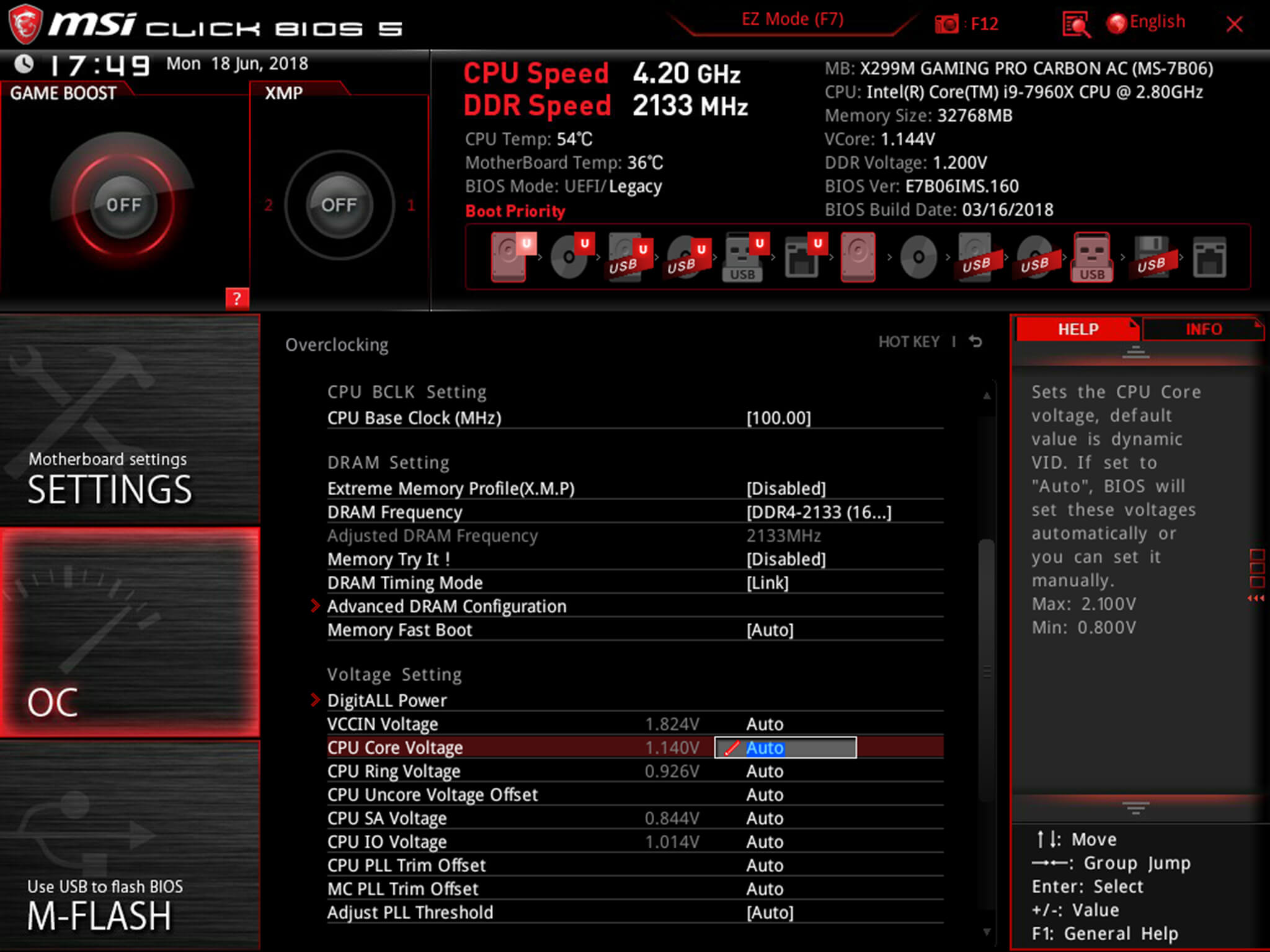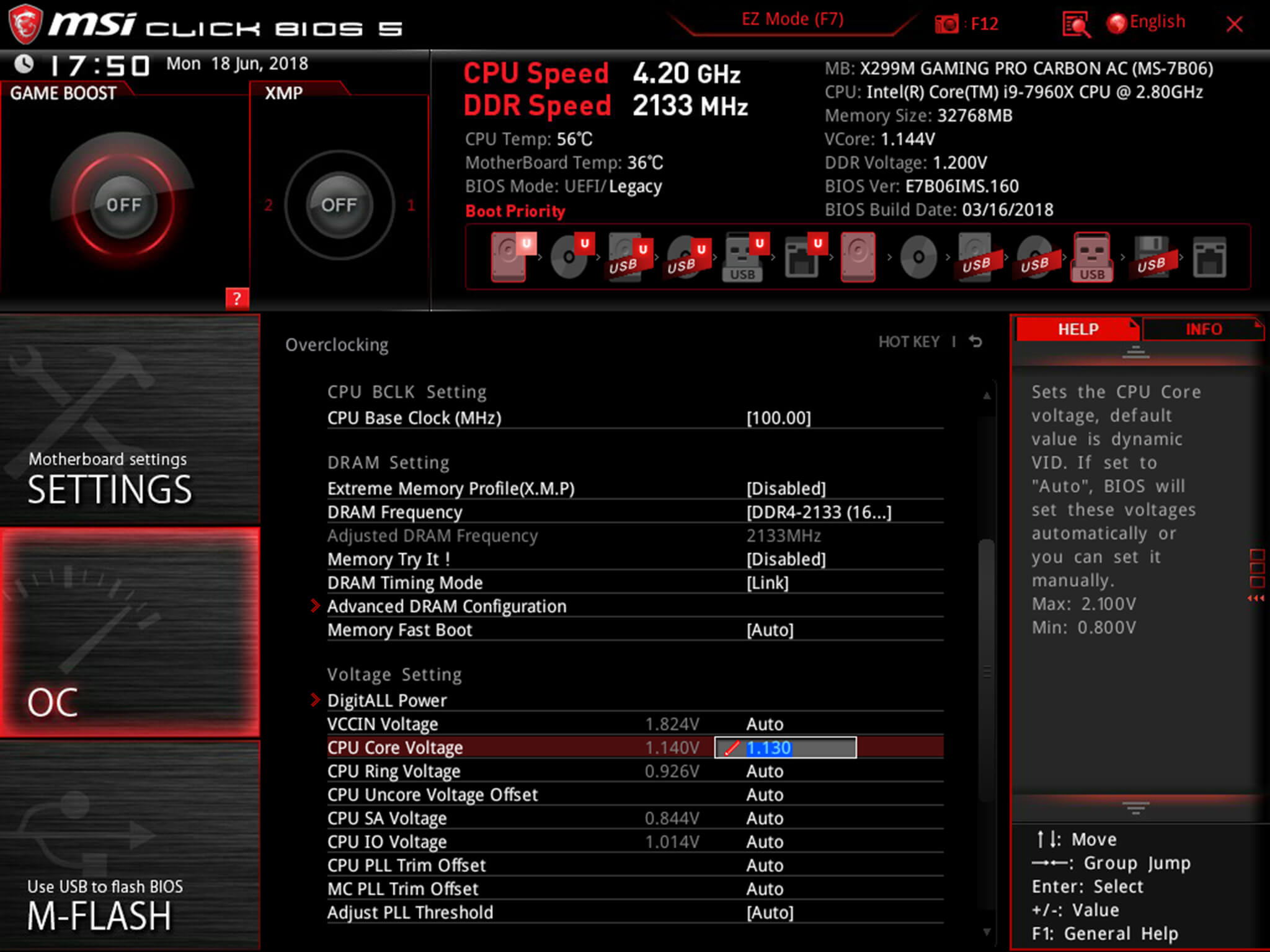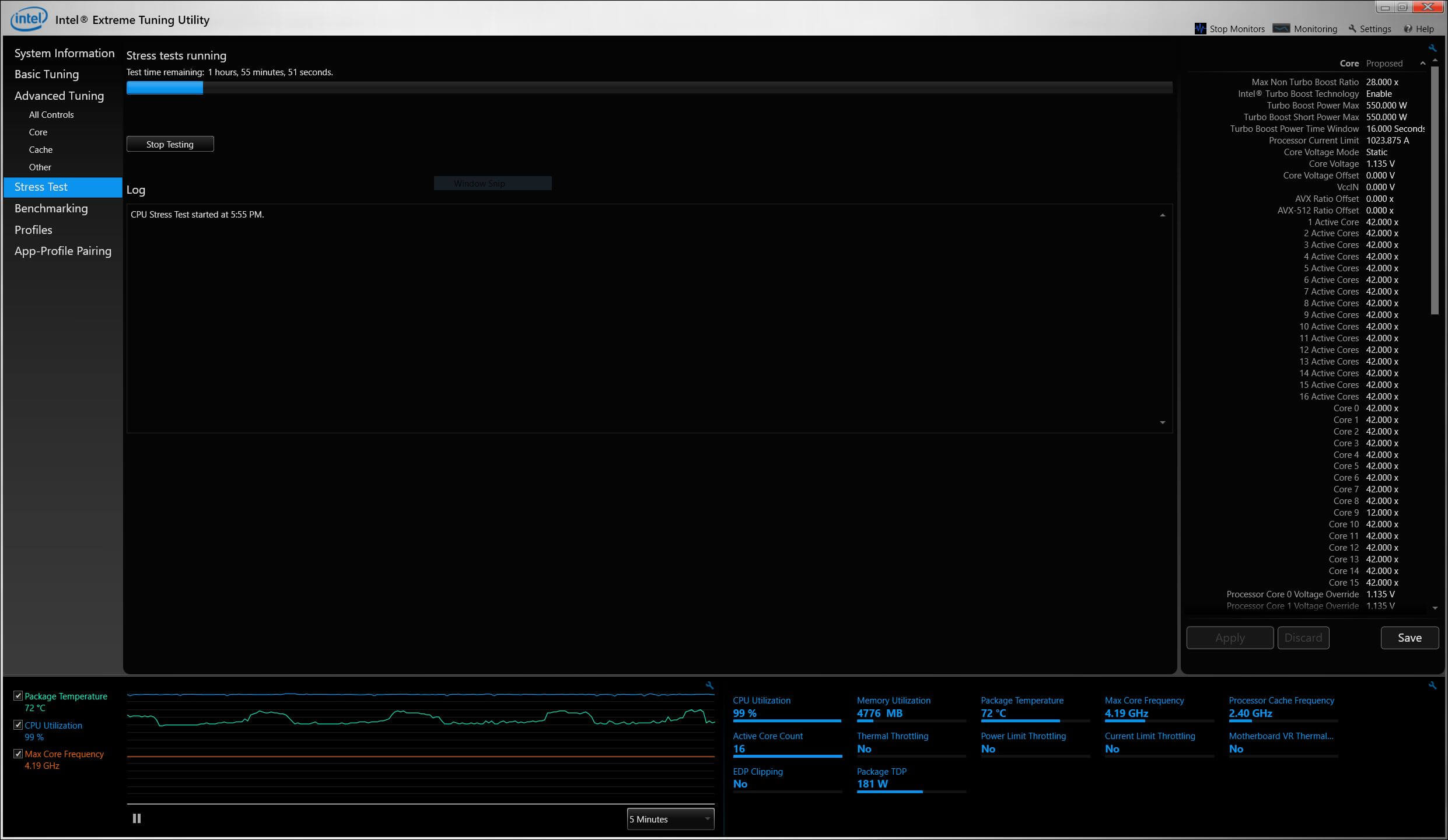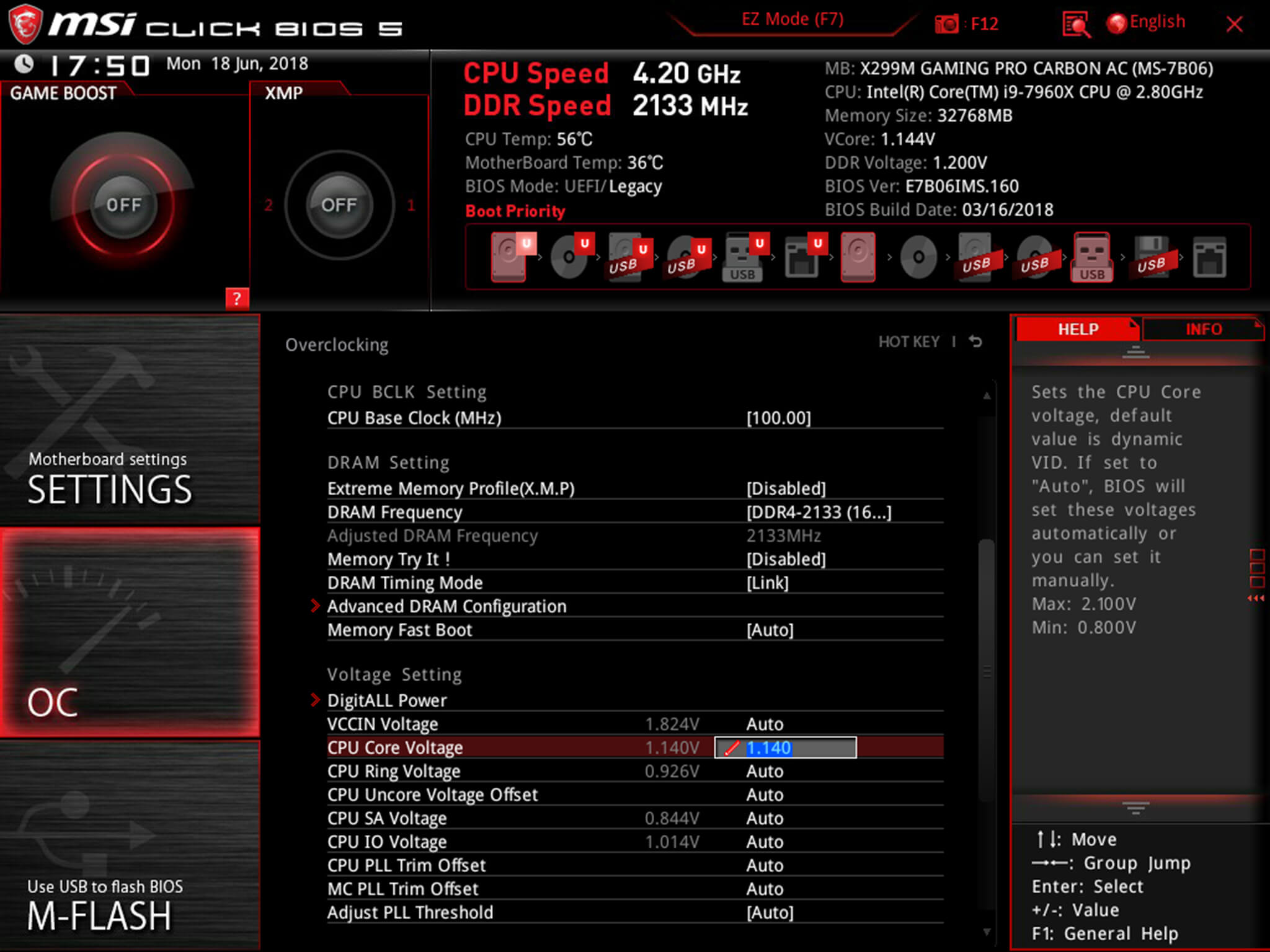The core voltage is different for each processor model, and while all CPUs of the same model have the same VID, not all samples maintain stability at the same clock speeds and Vcore due to slight variations in silicon quality. Every sample of the same CPU model is tested to maintain stability at the default speeds and the VID determined by the manufacturer.
Core voltage typically maintains a constant value while your CPU is in use; however, sometimes under heavy workloads vcore can fluctuate. This is known as Vdroop and can be corrected with load-line calibration. This applies additional voltage as load increases to maintain your CPU's stability.
When it comes to overclocking, you can only push your CPU's frequency so far before your CPU starts to experience instability. Programs might begin to crash or hang up, game performance could suffer or your computer could even fail to boot. This is because your processor isn't getting enough voltage to maintain system stability.
Increasing voltage will allow you to dial in the perfect overclock.
To adjust the voltage, you'll need to boot into your motherboard's BIOS and make adjustments there. The Vcore is expressed as a three decimal value, such as 1.235v. By default, the voltage control is set to auto; this can be overridden by typing in any value. Make sure not to exceed the recommended maximum for your processor.

Before fine-tuning the Vcore, it's important to find a good baseline value for a given speed. This varies from model to model but it can be helpful to read reviews for your CPU, specifically ones that focus on overclocking.
Most publications will list the voltage they required to keep several different speeds stable. Every CPU sample is different and you will need to fine-tune the voltage before calling it done; however, these values do provide a good starting point.

If you boot your machine and don't find any stability issues, then you know it's time to start decreasing the voltage. When overclocking, you want to find the lowest voltage required to maintain stability. More voltage equals more heat and this will allow you to keep temperatures under control.

The safest way to adjust voltage is with increments of .01 volts. Decrease voltage until your computer starts showing signs of instability under load. Use a program like Intel's Extreme Tuning Utility (XTU) or Prime95 to stress test your processor.
If the test fails or crashes, then you need to raise the voltage back up to the previous stable point. For optimal efficiency, you can increase the voltage by .005 instead and again test for stability.

Conversely, if your overclock isn't stable at your baseline voltage, you will then need to increase the voltage until your computer shows no adverse effects and then decrease in increments of .005 to fine tune.

Overclocking is not the only time it can be useful to adjust voltage. As mentioned, higher voltage levels cause your CPU to generate more heat, regardless of frequency. Some CPU samples may have a higher VID than is actually required at the default frequency. Undervolting your processor allows your to maintain stability while decreasing temperatures and extending the life of your processor.
It's a common misconception that disabling Turbo Boost is a more effective substitute for shedding heat. While this does result in decreased temperatures, it is not an alternative as the purpose of undervolting is to maintain the same level of performance while generating less heat. When making adjustments, the same principles apply here as with overclocking, decrease Vcore in increments of .01 and then fine tune with adjustments of .005.
 These apps and Twitter accounts will help you prepare for Hurricane Matthew
These apps and Twitter accounts will help you prepare for Hurricane Matthew
 Watch Melissa Etheridge sing a ditty about Brangelina's divorce
Watch Melissa Etheridge sing a ditty about Brangelina's divorce
 Few tears shed for Elizabeth Holmes as Theranos bleeds jobs
Few tears shed for Elizabeth Holmes as Theranos bleeds jobs
 Amazon Big Spring Sale 2025: Best air purifier deals from Dyson, Shark, LG, and more
Amazon Big Spring Sale 2025: Best air purifier deals from Dyson, Shark, LG, and more
 Dog refuses to part from beloved doughnut pillow
Dog refuses to part from beloved doughnut pillow
 The view from space as Hurricane Matthew pounded the Bahamas
The view from space as Hurricane Matthew pounded the Bahamas
 Man arrested for allegedly playing porn on a public billboard he 'hacked'
Man arrested for allegedly playing porn on a public billboard he 'hacked'
 Shop the Shark FlexStyle for 20% off at Amazon
Shop the Shark FlexStyle for 20% off at Amazon
 Disney World closes for 4th time in history thanks to Hurricane Matthew
Disney World closes for 4th time in history thanks to Hurricane Matthew
 Best portable power station deal: Save 44% on the Jackery Explorer 100 v2
Best portable power station deal: Save 44% on the Jackery Explorer 100 v2
 Here's how many people actually streamed the Streamy Awards
Here's how many people actually streamed the Streamy Awards
 Watch an IRL Dug from 'Up' surprise humans in the park
Watch an IRL Dug from 'Up' surprise humans in the park
 Stunning animated game helps teach endangered Aboriginal language
Stunning animated game helps teach endangered Aboriginal language
 Alienware M16 Gaming Laptop deal: Save $560
Alienware M16 Gaming Laptop deal: Save $560
 Oculus: 1 million people use VR every month
Oculus: 1 million people use VR every month
 Kardashian Klan returns to social media following Kim's robbery
Kardashian Klan returns to social media following Kim's robbery
 Airbnb hosts offer homes for $0 as Hurricane Matthew approaches
Airbnb hosts offer homes for $0 as Hurricane Matthew approaches
 Sony's pricey new compact cameras are pure performance
Sony's pricey new compact cameras are pure performance
The International by Richard BrodyThe Punk Ballerina by Miranda PopkeyMarnie the Dog's sister really, really hates copsWyatt Cenac's poignant, policeStaff Picks: Lawrence of Tell Halaf, Raging Nymphos by The Paris Review'Yellowjackets' Season 2, episode 5: Javi's drawing is a big cluePart 1: Nathaniel Rich’s Trousers by Clancy Martin'Yellowjackets' Season 2, episode 5: Javi's drawing is a big clueA Week in Culture: Matthew Specktor, Writer and Editor by Matthew SpecktorAnthony Caro by Ariel RamchandaniMichael Azerrad on ‘Our Band Could Be Your Life’ by Dawn ChanCalls to delete popular astrology app Co—Star after controversial protest memeFrancine Prose on 'My New American Life' by Thessaly La ForcePoem: Precautions by Catherine PierceAlexis Ohanian resigns from Reddit to make room for black board memberAnthony Caro by Ariel Ramchandani'Mrs Davis' review: Relentlessly original, but more trick than miracleYour climate change denial TikToks are getting deletedThe Artist in Isolation; BooPoem: Precautions by Catherine Pierce Australia votes for marriage equality, and the joy is infectious Elon Musk is going to host 'Saturday Night Live' for some reason Tim Cook congratulates Australia, but uses New Zealand flag How to use the YouTube mobile app's new data This slimy beast has people puzzled as to whether it's a dragon or a demogorgon Here's your first look at the purple iPhone 12 The female villains of the 'Falcon and the Winter Soldier' finale Avocado Rat is the millennial version of Pizza Rat Russia sent payments quite literally labeled 'to finance election campaign of 2016' Olympic athlete Ibtihaj Muhammad is getting her own Barbie Vivo V21 5G has a freakishly powerful selfie camera Justin Trudeau, your photo Uber will now deliver a rental car to your door — and pick it up when you're done Picky gorilla wanting to see more pictures of apes is all of us on dating apps Trump tried this special handshake and the photos aren't too... flattering How to set up Siri emergency calling with iOS 14.5 Apple Store goes down: Purple iPhone 12 and AirTag are coming Twitter updates policies with more words on why it won't ban Trump Lions surround you in this 360 You can finally unlock your iPhone with Apple Watch while wearing a mask
2.1121s , 10133.359375 kb
Copyright © 2025 Powered by 【Boobwatch 1 (1996)】,Miracle Information Network